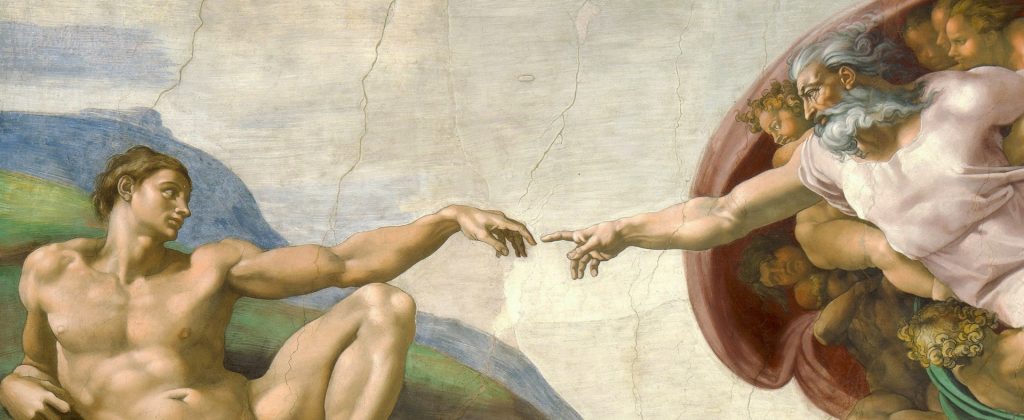On Religious Tolerance: Early Americans saw that Religious Coercion Opposes the Order of Nature
The Creation of Adam by Michelangelo, c1512.
Against the backdrop of religious persecution in England and Europe, British Quaker William Penn, who would later become the founder of the tolerant colony of Pennsylvania in 1681, wrote his revealing 1670 essay in defense of freedom of belief, A Great Case of Liberty of Conscience Debated and Defended by the Authority of Reason, Scripture, and Antiquity. His position would later be reflected in the ideas and writings of John Locke and of the American Founders in support of religious freedom in the United States. One of Penn’s specific arguments was that religious coercion is contrary to the order of nature.
Religious coercion, Penn argued, opposes the order of nature because it disregards man’s natural, God-given faculties of intellect and choice. It also destroys in persecutors the basic affinity that a person normally, naturally possesses for another human being. Penn explains:
If God almighty has made of one blood all nations, as He Himself has declared, and has given them [mankind] both corporeal and intellectual senses to discern things and their differences, so as to assert or deny from evidences and reasons proper to each; then where anyone enacts the belief or disbelief of anything upon the rest, or restrains any from the exercise of their faith, to them indispensable, such a one exalts himself beyond his bounds, enslaves his fellow creatures, invades their right of liberty, and so perverts the whole order of nature.
What is more, religious coercion denies mankind’s spiritual nature and his capacity for faith and relationship with God. Each human being possesses the ability and privilege to relate with God, his or her Creator, “that instinct of a Deity which is so natural to him that he can be no more without it than he can be without the most essential part of himself.” Coercion thus interferes in man’s relationship with God.
For these reasons, Penn concluded that religious coercion is contrary to the natural order of creation.
Contributed by AHEF and Angela E. Kamrath.
—–
Source for more information: Kamrath, Angela E. The Miracle of America: The Influence of the Bible on the Founding History and Principles of the United States of America for a People of Every Belief. Second Edition. Houston, TX: American Heritage Education Foundation, 2014, 2015.
Additional Reading/Handout: Why Religious Freedom Became an Unalienable Right & First Freedom in America by Angela E. Kamrath, American Heritage Education Foundation. Paper available to download from member resources, americanheritage.org.
Related posts/videos:
1. An Introduction to Popular Sovereignty
2. Challenges in the Early Puritan Colonies: The Dilemma of Religious Laws and Dissent
3. The Two Kingdoms Doctrine : Religious Reformers Recognize the Civil and Spiritual Kingdom
4. The First Experiments in Freedom of Belief & Religious Tolerance in America
5. Roger Williams: His Quest for Religious Purity and Founding of Rhode Island
6. Roger Williams: First Call for Separation of Church and State in America
7. William Penn and His “Holy Experiment” in Religious Tolerance
8. Early Americans supported Religious Tolerance based on God as Judge of Conscience
9. Early Americans opposed Religious Persecution as contrary to the Biblical Teachings of Christ
10. Early Americans Believed Religious Coercion Opposes Reason
11. Early Americans Supported Religious Tolerance within Civil Peace and Order
12. Philosopher John Locke & His Letters Concerning Toleration
13. The Religious Landscape of the Thirteen Colonies in Early 1700s America
—–
Activity: The Miracle of America High School Teacher Course Guide, Unit 4, Part 1, Activity 3: The Importance of Religious Freedom in Human Life, p. 146-7. MS-HS.
The Importance of Religious Freedom in Human Life
Purpose/Objective: Students consider the cultural and geographic factors that affect one’s philosophical/religious views, reflect on the importance of religious freedom in human life and in their own lives, and learn why religious oppression is a cause for conflict and/or migration.
Suggested Readings:
1) Chapter 4 of Miracle of America sourcebook/text. Students read sections Introduction, 4.1, 4.9, 4.10.
2) Paper/handout titled Why Religious Freedom Became an Unalienable Right & First Freedom in America by Angela E. Kamrath (AHEF). Paper available to download from member resources, americanheritage.org.
3) Related articles/videos (see above).
4) William Penn, A Great Case of Liberty of Conscience Debated and Defended by the Authority of Reason, Scripture, and Antiquity, 1670.
Activity: Journal/Reflection Writing. Students journal/reflect on the questions below:
1. In what ways, if at all, might cultural, social, historical, and geographic factors relate to one’s philosophical/religious views? In what ways, if any, might they not relate?
2. Why do you think religious freedom is so important to people, to human life? Students consider the ways a person’s philosophical/religious beliefs and worldview affect his or her life purpose/meaning (raison d’etre), lifestyle, choices, decisions, and view of afterlife or eternal destiny. Students may think/write about their own worldview, beliefs, values, and experiences and how they have benefited from religious freedom.
3. Why is religious intolerance or oppression a significant cause for conflict and migration/immigration? Think of some historical and modern examples. Students may also think/write about what life would be like without religious freedom.
Discussion may follow.
—–
To download this whole unit, sign up as an AHEF member (no cost) to access the “resources” page on americanheritage.org. To order the printed binder format of the course guide with all the units, go to the AHEF bookstore.
Copyright © American Heritage Education Foundation. All rights reserved.
